
Chocolate Easter eggs hidden as part of an egg hunt
An egg hunt is an Eastertide game during which decorated eggs or Easter eggs are hidden for children to find. Real hard-boiled eggs, which are typically dyed or painted, artificial eggs made of plastic filled with chocolate or candies, or foil-wrapped egg-shaped chocolates of various sizes are hidden in various places; as many people give up sweets as their Lenten sacrifice, individuals consume them after having abstained from them during the preceding forty days of Lent.[1]
The game is often played outdoors, but can also be played indoors. The children typically collect the eggs in a basket. When the hunt is over, prizes may be given out for various achievements, such as the largest number of eggs collected, for the largest or smallest egg, for the most eggs of a specific color, consolation prizes or booby prizes.[2] Real eggs may further be used in egg tapping contests. If eggs filled with confetti left from Mardi Gras (cascarones) are used, then an egg fight may follow.[2] Eggs are placed with varying degree of concealment, to accommodate children of varying ages and development levels. In South German folk traditions it was customary to add extra obstacles to the game by placing them into hard-to reach places among nettles or thorns.[3]
https://en.wikipedia.org/wiki/Egg_hunt
https://en.wikipedia.org/w/index.php?title=Easter_egg_hunt&redirect=no
Easter,[nb 1] also called Pascha[nb 2] (Aramaic, Greek, Latin) or Resurrection Sunday,[nb 3] is a Christian festival and cultural holiday commemorating the resurrection of Jesus from the dead, described in the New Testament as having occurred on the third day of his burial following his crucifixion by the Romans at Calvary c. 30 AD.[12][13] It is the culmination of the Passion of Jesus Christ, preceded by Lent (or Great Lent), a 40-day period of fasting, prayer, and penance.
https://en.wikipedia.org/wiki/Easter
Adalbert of Prague | |
|---|---|
 | |
| Bishop and Martyr | |
| Born | c. 956 Libice nad Cidlinou, Duchy of Bohemia (now the Czech Republic) |
| Died | 23 April 997 (aged 40–41) Święty Gaj or Primorsk, Prussia (now Poland or Russia) |
| Venerated in | Catholic Church Eastern Orthodox Church |
| Canonized | 999[1], Rome by Pope Sylvester II |
| Major shrine | Gniezno, Prague |
| Feast | 23 April |
| Attributes | spears [2] |
| Patronage | Poland, Czech Republic, Archdiocese of Esztergom, Archdiocese of Prague (primary) |
Adalbert of Prague (Latin: Sanctus Adalbertus, Czech: svatý Vojtěch, Slovak: svätý Vojtech, Polish: święty Wojciech, Hungarian: Szent Adalbert (Béla); c. 956 – 23 April 997), known in the Czech Republic, Poland and Slovakia by his birth name Vojtěch (Latin: Voitecus), was a Czech missionary and Christian saint.[3] He was the Bishop of Prague and a missionary to the Hungarians, Poles, and Prussians, who was martyred in his efforts to convert the Baltic Prussians to Christianity. He is said to be the composer of the oldest Czech hymn Hospodine, pomiluj ny and Bogurodzica, the oldest known Polish hymn, but his authorship of them has not been confirmed.[4]
Adalbert was later declared the patron saint of the Czech Republic, Poland, and the Duchy of Prussia. He is also the patron saint of the Archdiocese of Esztergom in Hungary.[5]
https://en.wikipedia.org/wiki/Adalbert_of_Prague
Vitus | |
|---|---|
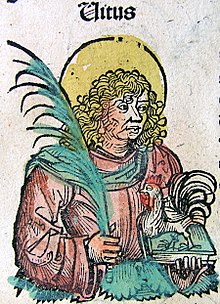 Saint Vitus, from the Nuremberg Chronicle, 1493 | |
| Martyr, Holy Helper | |
| Born | c. 290 Mazzara del Vallo, Sicily |
| Died | c. 303 (age 12–13) Lucania, modern-day Basilicata, Italy |
| Venerated in | Roman Catholic Church Eastern Orthodox Church |
| Feast | 15 June |
| Attributes | depicted in a cauldron, with a rooster or a lion |
| Patronage | actors; comedians; Rijeka, Croatia; Czechoslovakia; dancers; dogs; epilepsy; Mazara del Vallo, Sicily; Forio, Ischia; oversleeping; Prague, Czech Republic; rheumatic chorea (Saint Vitus Dance); Serbia; snake bites; storms; Vacha, Germany; Zeven, Lower Saxony; the Gooi, Netherlands; E Clampus Vitus |
Vitus (/ˈvaɪtəs/), whose name is sometimes rendered Guy or Guido, was a Christian martyr from Sicily. His surviving hagiography is pure legend. The dates of his actual life are unknown.[1][2] He has for long been tied to the Sicilian martyrs Modestus and Crescentia but in the earliest sources it is clear that these were originally different traditions that later became combined.[3] The figures of Modestus and Crescentia are probably fictitious.[1]
According to his legend, he died during the Diocletianic Persecution in AD 303. In the Middle Ages, he was counted as one of the Fourteen Holy Helpers. In Germany, his feast was celebrated with dancing before his statue. This dancing became popular and the name "Saint Vitus Dance" was given to the neurological disorder Sydenham's chorea. It also led to Vitus being considered the patron saint of dancers and of entertainers in general.[4] He is also said to protect against lightning strikes, animal attacks and oversleeping. His feast day is celebrated on 15 June. In places where the Julian calendar is used, this date coincides, in the 20th and 21st centuries, with 28 June on the Gregorian calendar.
https://en.wikipedia.org/wiki/Saint_Vitus
Peter the Apostle | |
|---|---|
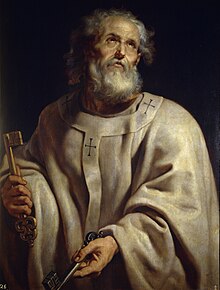 Saint Peter (c. 1610–1612) by Peter Paul Rubens, depicting Peter, vested in the pallium, and holding the Keys of Heaven. | |
| Church | Early Christian |
| See |
|
| Papacy began | AD 30[1] |
| Papacy ended | Between AD 64–68[1] |
| Successor | |
| Orders | |
| Ordination | by Jesus Christ, AD 30 |
| Personal details | |
| Born | Shimon Bar Yonah (Hebrew: שמעון בר יונה) (Simeon, Simon) c. AD 1 |
| Died | Between AD 64–68 probably Vatican Hill, Rome, Italia, Roman Empire[3][4] |
| Parents | John (or Jonah; Jona) |
| Occupation | Fisherman, clergyman |
| Sainthood | |
| Feast day |
|
| Venerated in | All Christian denominations that venerate saints and in Islam |
| Canonized | Pre-Congregation |
| Attributes | Keys of Heaven, Red Martyr, pallium, papal vestments, man crucified upside down, vested as an Apostle, holding a book or scroll, Cross of Saint Peter |
| Patronage | Patronage list |
| Shrines | St. Peter's Basilica |
Saint Peter[note 1] (died between AD 64 and 68),[1] also known as Peter the Apostle, Simon Peter, Simeon, Simon, or Cephas (lit. 'rock'),[6] was one of the Twelve Apostles of Jesus Christ and one of the first leaders of the early Christian Church. He appears repeatedly and prominently in all four New Testament gospels as well as the Acts of the Apostles.
https://en.wikipedia.org/wiki/Saint_Peter
Michael | |
|---|---|
 Saint Michael in The Fall of the Rebel Angels by Luca Giordano | |
| Archangel, Prince (Commander) of the Heavenly Host | |
| Venerated in | Judaism All Christian denominations which venerate saints Islam Baháʼí Faith |
| Major shrine | Mont-Saint-Michel, The Sanctuary of Saint Michael the Archangel |
| Feast |
|
| Attributes | banner, scales, weighing souls, sword, slaying Satan or a dragon |
| Patronage | Protector of the Jewish people,[1] Guardian of the Catholic Church,[2] Vatican City[3][4] France, Germany, Normandy, Poor souls, against lightningstroke and windstorm[5] |
Michael,[Notes 1] also called Saint Michael the Archangel, Archangel Michael and Saint Michael the Taxiarch[6] is an archangel in Judaism, Christianity, Islam, and the Baha'i faith. The earliest surviving mentions of his name are in 3rd and 2nd-century BC Jewish works, often but not always apocalyptic, where he is the chief of the angels and archangels, and he is the guardian prince of Israel and is responsible for the care of Israel.[7][8][9][10] Christianity adopted nearly all the Jewish traditions concerning him,[11] and he is mentioned explicitly in Revelation 12:7–12,[12] where he does battle with Satan,[13] and in the Epistle of Jude, where the author denounces heretics by contrasting them with Michael.[14]
https://en.wikipedia.org/wiki/Michael_(archangel)
George | |
|---|---|
 Portrait by Hans von Kulmbach, c. 1510 | |
| Martyr, Patron of England | |
| Born | Cappadocia (modern-day Turkey) |
| Died | 23 April 303 Lydda, Syria Palaestina (modern-day Lod, Israel)[1][2] |
| Venerated in | |
| Major shrine | |
| Feast |
|
| Attributes | Clothed as a crusader in plate armour or mail, often bearing a lance tipped by a cross, riding a white horse, often slaying a dragon. In the Greek East and Latin West he is shown with St George's Cross emblazoned on his armour, or shield or banner. |
| Patronage | Many patronages of Saint George exist around the world |
Saint George (Greek: Γεώργιος, translit. Geṓrgios, Latin: Georgius, Georgian: გიორგი, translit. Giorgi, Syriac: ܡܪܝ ܓܘܪܓܝܣ, romanized: Mar Giwargis Arabic: القديس جرجس; died 23 April 303), also George of Lydda, was a Christian who is venerated as a saint in Christianity. According to tradition, he was a soldier in the Roman army. He was of Cappadocian Greek origin and a member of the Praetorian Guard for Roman emperor Diocletian, but was sentenced to death for refusing to recant his Christian faith. He became one of the most venerated saints and megalomartyrs in Christianity, and he has been especially venerated as a military saint since the Crusades. He is respected by Christians, Druze, as well as some Muslims as a martyr of monotheistic faith.
https://en.wikipedia.org/wiki/Saint_George
Brigid of Kildare / Saint Brigid of Ireland | |
|---|---|
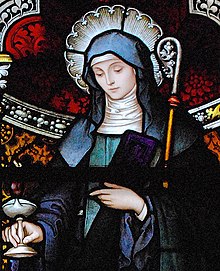 Saint Brigid of Ireland in stained glass at St. Joseph Catholic Church in Macon, Georgia, United States | |
| Virgin | |
| Born | c. 451 Faughart, Dundalk, Kingdom of Ulaid[1][2] Gaelic Ireland |
| Died | c. 525 (age 74) Kildare, Kingdom of Leinster, Gaelic Ireland |
| Venerated in | Catholic Church Anglican Communion Eastern Orthodox Church |
| Feast | 1 February |
| Attributes | Brigid's cross; crozier of an abbess; flames or lamp; cow or geese[3] |
| Patronage | Kildare; Ireland; healers; poets; blacksmiths; livestock and dairy workers[3] |
Saint Brigid of Kildare or Saint Brigid of Ireland (Irish: Naomh Bríd; Classical Gaelic: Brighid; Latin: Brigida; c. 451 – 525) is the patroness saint (or 'mother saint') of Ireland, and one of its three national saints along with Patrick and Columba. According to medieval Irish hagiographies, she was an abbess who founded the important abbey of Kildare (Cill Dara),[4] as well as several other convents of nuns. There are few historical facts about her, and her hagiographies are mainly anecdotes and miracle tales, some of which are rooted in pagan folklore.[3] They say Brigid was the daughter of a chieftain and a slave woman, and was raised in a druid's household before becoming a consecrated virgin. She is patroness of many things, including poetry, learning, healing, protection, blacksmithing, livestock and dairy production. In her honour, a perpetual fire was kept burning at Kildare for centuries.
https://en.wikipedia.org/wiki/Brigid_of_Kildare
Catherine of Siena | |
|---|---|
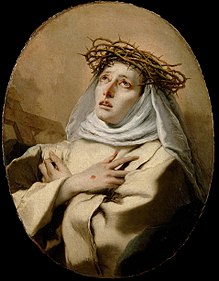 St. Catherine of Siena, by Giovanni Battista Tiepolo | |
| Doctor of the Church, Virgin | |
| Born | 25 March 1347 Siena, Republic of Siena |
| Died | 29 April 1380 (aged 33) Rome, Papal States |
| Venerated in | Catholic Church Anglican Communion[1] Lutheranism[2] |
| Beatified | 29 December 1460 |
| Canonized | 29 June 1461 by Pope Pius II |
| Major shrine | Santa Maria sopra Minerva, Rome and the Sanctuary of Saint Catherine, Siena |
| Feast | 29 April; 30 April (Roman Calendar, 1628–1969); 4 October (in Italy) |
| Attributes | habit of a Dominican tertiary, ring, lily, cherubim, crown of thorns, stigmata, crucifix, book, heart, skull, dove, rose, miniature church, miniature ship bearing Papal coat of arms |
| Patronage | against fire; bodily ills; people ridiculed for their piety; nurses; sick people; miscarriages; Europe; Italy; Diocese of Allentown, Pennsylvania, USA; Bambang, Nueva Vizcaya, Philippines; Samal, Bataan, Philippines |
Catherine of Siena, TOSD (Italian: Caterina da Siena; 25 March 1347 – 29 April 1380) was an Italian member of the Third Order of Saint Dominic in the Roman Catholic Church. She was a mystic, activist, and author who had a great influence on Italian literature and on the Catholic Church. Canonized in 1461, she is also a Doctor of the Church.
https://en.wikipedia.org/wiki/Catherine_of_Siena
John Cantius | |
|---|---|
 Saint John Cantius | |
| Confessor | |
| Born | June 23, 1390 Kęty, Oświęcim, Crown of the Kingdom of Poland |
| Died | December 24, 1473 (aged 83) Kraków, Crown of the Kingdom of Poland |
| Venerated in | Catholic Church |
| Beatified | 28 March 1676, Rome by Pope Clement X |
| Canonized | 1767, Rome by Pope Clement XIII |
| Major shrine | Church of St. Anne Kraków, Poland |
| Feast | 23 December 20 October (Poland, General Roman Calendar 1770–1969) |
| Attributes | in a professor's gown with his arm around shoulder of a young student whose gaze is directed towards Heaven; giving his garments to the poor |
| Patronage | Poland; Lithuania; Jagiellonian University Theology career |
| Education | Kraków Academy |
| Theological work | |
| Main interests | Biblical studies |
Church of St. Anne, Kraków, Poland.
John Cantius (Latin: Joannes Cantius; Polish: Jan z Kęt or Jan Kanty; 23 June 1390 – 24 December 1473) was a Polish priest, scholastic philosopher, physicist and theologian.
https://en.wikipedia.org/wiki/John_Cantius
| Stephen III the Great | |
|---|---|
 | |
| Prince of Moldavia | |
| Reign | 1457–1504 |
| Predecessor | Peter III Aaron |
| Successor | Bogdan III |
| Born | 1433–1440 Borzești |
| Died | 2 July 1504 (aged 64-71) Suceava |
| Burial | |
| Spouse | Mărușca (?) Evdochia of Kiev Maria of Mangup Maria Voichița of Wallachia |
| Issue more... | Alexandru Bogdan III Petru Rareș |
| Dynasty | Mușat |
| Father | Bogdan II of Moldavia |
| Mother | Maria Oltea |
| Religion | Orthodox Christian |
Stephen III of Moldavia, most commonly known as Stephen the Great (Romanian: Ștefan cel Mare; pronunciation: [ˈʃtefan tʃel ˈmare], but has been venerated since 1992 as Saint Stephen the Great or as Stephen the Great and Holy (Romanian: Ștefan cel Mare și Sfânt: he died on 2 July 1504, was Voivode and Prince of Moldavia from 1457 to 1504. He was the son of and co-ruler with Bogdan II, who was murdered in 1451 in a conspiracy organized by his brother and Stephen's uncle Peter III Aaron, who took the throne. Stephen fled to Hungary, and later to Wallachia; with the support of Vlad III Țepeș, Voivode of Wallachia, he returned to Moldavia, forcing Aaron to seek refuge in Poland in the summer of 1457. Teoctist I, Metropolitan of Moldavia, anointed Stephen prince. He attacked Poland and prevented Casimir IV Jagiellon, King of Poland, from supporting Peter Aaron, but eventually acknowledged Casimir's suzerainty in 1459.
https://en.wikipedia.org/wiki/Stephen_the_Great
Nicholas | |
|---|---|
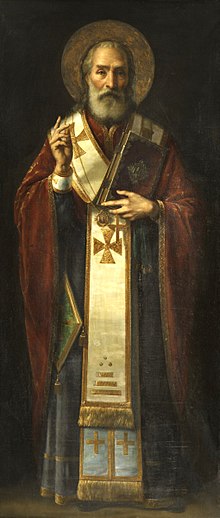 Full-length icon by Jaroslav Čermák, showing Saint Nicholas with a halo, dressed in clerical garb, and holding a book of the scriptures in his left hand while making the hand gesture for the sign of the cross with his right | |
| |
| Born | Traditionally 15 March 270[1] Patara, Lycia et Pamphylia, Roman Empire |
| Died | Traditionally 6 December 343 (aged 73) Myra, Diocese of Asia, Roman Empire |
| Venerated in | All Christian denominations which venerate saints |
| Major shrine | Basilica di San Nicola, Bari, Italy |
| Feast |
|
| Attributes | Vested as a bishop. In Eastern Christianity, wearing an omophorion and holding a Gospel Book. Sometimes shown with Jesus Christ over one shoulder, holding a Gospel Book, and with the Theotokos over the other shoulder, holding an omophorion, holding three golden balls or coins |
| Patronage |
|
Saint Nicholas of Myra[a] (traditionally 15 March 270 – 6 December 343),[3][4][b] also known as Nicholas of Bari, was an early Christian bishop of Greek descent from the maritime city of Myra in Asia Minor (Greek: Μύρα; modern-day Demre, Turkey) during the time of the Roman Empire.[7][8] Because of the many miracles attributed to his intercession, he is also known as Nicholas the Wonderworker.[c] Saint Nicholas is the patron saint of sailors, merchants, archers, repentant thieves, children, brewers, pawnbrokers, unmarried people, and students in various cities and countries around Europe. His reputation evolved among the pious, as was common for early Christian saints, and his legendary habit of secret gift-giving gave rise to the traditional model of Santa Claus ("Saint Nick") through Sinterklaas.
https://en.wikipedia.org/wiki/Saint_Nicholas
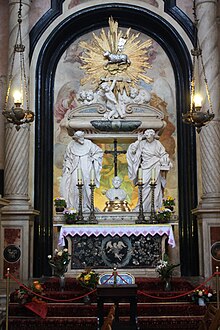
No comments:
Post a Comment